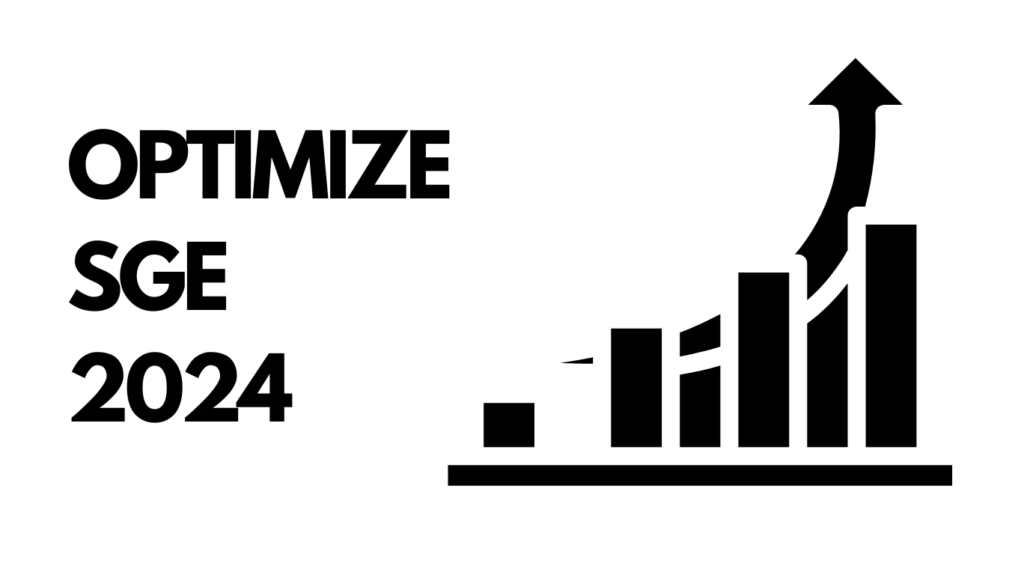AI is revolutionizing the world of search, and Google is developing a new type of search called SGE (Search Generative Experience).
Today, we’ll focus on SEO for AI search, specifically Google’s new generative AI search engine, SGE. This represents a profound shift in digital marketing and search. Many people are unaware of SGE’s existence, but we anticipate its launch by Google in the coming months. We have been testing it extensively this year and have developed effective strategies for ranking in it. To our knowledge, this information hasn’t been shared by any other agency. Let’s dive into how to achieve high rankings in SGE.
What is SGE?
If you don’t know what it is, we’re going to be doing a bit of an overview. Then I’m going to show you some case studies. So some before and afters of getting web pages ranking in this brand new type of search and breaking down exactly what strategies you need to do to get those rankings. At the end, I’m also then going to show you an approach that you can use to identify the most important ranking strategies and the most important opportunities to pick up SGE ranking. This is going to be fantastically useful if you’re an agency or you’re an in-house marketer and you want to be able to get your website ranking in this brand new search when most people don’t even know that this thing exists yet.
Interactive Segment
Let’s begin with a quick survey to understand your familiarity with SGE. Please answer the following questions in the chat:
- Have you heard of SGE?
- If yes, have you used it?
A poll will appear in the chat window for your responses. Over the past month, we’ve conducted several in-person seminars, engaging with around 700 people. Interestingly, only about 1% of agencies and digital marketers have heard of SGE, and even fewer have used it.
Current Poll Results:
- 50% of participants have not heard of SGE.
- 16% have heard of it and have used it.
- The numbers are still updating, but it’s clear many are new to this topic.
Overview and Strategies:
For those unfamiliar with SGE, we’ll provide a comprehensive overview. For those who know about SGE, we’ll explore advanced ranking strategies you may not have seen before.
Feel free to continue submitting your questions in the chat. We will have a dedicated Q&A session at the end to address as many as possible.
The Significance of SGE
SGE represents a profound shift in SEO and digital marketing. Having started with Google Ads in 2006 and optimized for Google over the past 18 years, I can confidently say this is the most significant change I’ve seen. This shift will fundamentally alter how marketers interact with Google.
Traditional Google Search Results
Let’s examine the current structure of a Google search results page.
- Featured Snippet: At the top, you’ll often find a featured snippet, a piece of text taken from a website, with a link to the source. This indicates an informational search term.
- People Also Ask (PAA): Below the featured snippet is the PAA section. Each dropdown reveals a brief answer with a link to the source website.
- Organic Results: Following the PAA, you’ll see the regular organic search results.
- Additional Elements: Depending on the search term, there might be images, shopping listings, local listings, movie times, or weather updates.
The primary goal of a Google search results page has always been to list websites with relevant links, driving traffic to those sites. As marketers, our objective has been to optimize our websites to attract clicks from searchers, ensuring our content stands out among competitors.
This familiar structure is about to change with the introduction of SGE, redefining how we approach SEO and digital marketing.
How SGE Differs
SGE presents a radically different search experience. Here’s how:
New Layout and Features
- AI-Generated Information: On the left side of the search results page, you’ll see AI-generated content from Google’s large language model, aiming to answer the searcher’s query directly on the page.
- Carousel Section: To the right, there is a carousel of linked websites. Each site includes a featured image, title, link, and favicon.
- Follow-Up Questions: Users can ask follow-up questions directly on the page, engaging more dynamically with the search results.
Impact on Organic Listings
In the traditional search layout, organic listings were prominently featured. With SGE, these listings are pushed further down the page. Notably, the familiar “10 blue links” are no longer visible above the fold, replaced entirely by Google’s AI-generated responses.
Implications for SEO
This shift has significant implications for SEO:
- Visibility: Organic listings are less visible, potentially reducing website traffic.
- Optimization: The focus will need to shift towards optimizing for AI-generated content and featured positions in the carousel.
Overall, SGE is a profound change that will require new strategies for maintaining and improving website visibility in search results.
SGE for Branded Searches
SGE also impacts branded searches, not just informational ones. Let’s take a look at an example.
SGE Approach
With SGE, the search results page changes significantly:
- Generative AI Section: A large AI-generated section appears at the top, pushing other content further down the page. This section includes:
- Information: Summarized from various sources around the internet.
- Images: Pulled from the Google Business page.
- Reviews: Displayed prominently.
- Carousel of Websites: A carousel at the top features up to three websites by default, with more visible upon scrolling (up to nine). Each site includes a featured image, title, and link.
- Drop-Down Links: Clicking on drop-down links under paragraphs shows websites that corroborate the information.
Implications
This shift indicates a fundamental change in how Google serves branded search results:
- From Websites to Answers: Google is moving from simply listing websites to providing comprehensive answers directly on the search page.
- Visibility: Branded websites are still present but are now less prominent, requiring new strategies to maintain visibility.
- Opportunities: There are new opportunities to get featured in the generative AI section and carousel, emphasizing the need for updated SEO tactics.
Overall, SGE changes the landscape of branded searches by prioritizing AI-generated content and pushing traditional organic listings further down.
Profound Impact on SEO
SGE introduces a new way to interact with Google, fundamentally changing how search results are presented and engaged with.
Interactive Search Experience
SGE allows users to ask follow-up questions, creating a conversational search experience. For example, when someone searches for “Exposure Ninja reviews,” SGE generates an answer by aggregating information from various review sites. This provides a comprehensive overview rather than directing users to individual websites.
Shift in Google’s Goal
Historically, Google aimed to show websites with the best information. However, with SGE, Google’s goal has shifted to answering search queries directly within the search results page.
- Traditional Goal: Display websites containing the best information.
- New Goal: Provide direct answers within the search results, reducing the need for users to visit individual websites.
Difference from Featured Snippets
While Google has been moving towards direct answers with featured snippets, SGE is a more significant shift:
- Featured Snippets: Attribute information to a single website.
- SGE: Aggregates information from multiple sources with fewer direct attributions.
This change means that the traditional organic listings are now less prominent, focusing on providing immediate answers to users’ queries.
SGE represents a major transformation in Google’s search results handling. It emphasizes direct answers and aggregated information over directing traffic to individual websites. This shift will require new strategies for maintaining visibility and engagement in search results.
Potential Impact on Traffic
The impact of SGE on organic traffic is still uncertain. Currently, SGE is in the testing phase within Google Labs and is only accessible to users in the US who are signed up for Labs and using a Google browser like Chrome. As a result, there’s no definitive data from Google on how SGE will affect organic traffic.
Projections and Studies
Despite the lack of concrete data, some agencies have attempted to estimate the potential impact of SGE on website traffic. Agile SEO conducted a study projecting the possible effects on organic traffic across different scenarios:
- Best Case Scenario: An average organic traffic drop of 18%.
- Worst Case Scenario: An average organic traffic drop of 64%.
These projections indicate that SGE could lead to significant reductions in organic traffic, highlighting the need for new strategies to adapt to this changing search landscape.
As SGE continues to develop and more data becomes available, marketers must stay informed and adjust their SEO strategies accordingly to mitigate potential traffic losses.
Optimizing for SGE
First, it’s important to note that while some projections about the impact of SGE on organic traffic might seem pessimistic, the actual impact could be less severe. It may be about half of what some studies suggest. Additionally, some websites that optimize well for SGE could see traffic increases, making this a potentially positive development for those who adapt effectively.
Key Areas of Impact
We anticipate the primary impacts of SGE will be in several key areas:
- Informational Organic Traffic: There will likely be a drop in traffic for informational queries, as SGE provides direct answers within the search results, reducing the need for users to visit multiple websites.
- Customer Research on Google: More of the customer’s research process is expected to happen directly on Google. For example, if someone is researching to buy a new phone, their journey might typically involve multiple searches and visits to various websites.
Example of a Customer Journey
Currently, a typical research journey might look like this:
- Search for “best camera phones” and visit several websites.
- Narrow the search to “Android vs iPhone” and visit more websites.
- Decide on iPhone and search “best iPhones 2023,” followed by “15 Pro Max reviews,” and visit additional websites.
In this process, a user might conduct 10 searches and visit 30 different websites.
SGE’s Approach
SGE aims to keep much of this research within the search results page:
- Aggregated Information: SGE provides comprehensive answers, reducing the need for multiple website visits.
- Interactive Q&A: Users can interact with SGE to get detailed information, which could limit website visits to just the final purchase site.
Top of Funnel Visitors
We expect a decline in top-of-funnel visitors, as informational queries—which typically sit at the top of the funnel—are answered directly by SGE. This shift could significantly impact industries like affiliate marketing and lead generation, where capturing emails and nurturing leads through content is crucial.
Concerns Over Content Strategy
This change raises valid concerns for businesses about the value of producing content if Google is answering queries directly, potentially consuming all the traffic and using the information without driving visitors to original websites. Such doubts could lead to uncertainty and fear regarding content strategies.
The Future of SGE
Some may hope that SGE, currently in testing and not fully rolled out, might eventually be scrapped. However, this is unlikely. Google CEO Sundar Pichai emphasized in their Q2 earnings call that SGE represents a significant evolution in search, stating, “Over time, this will be just how search works. We are building the next major revolution in search.”
Google’s Commitment to SGE
Google is strongly committed to SGE, viewing it as the future of search and a way to compete with ChatGPT. This commitment is evident from their investor calls, where they report positive feedback and strong support for SGE. Unlike their interactions with the SEO community, customers, and regulators, Google must be transparent with its investors. Their bullish stance on SGE in these calls suggests an imminent rollout.
Integration with Gemini
SGE’s capabilities are expected to improve further with integration with Gemini, enhancing its performance and reliability.
In conclusion, businesses should prepare for the rollout of SGE, adapt their strategies, and explore ways to optimize for this new search landscape. Ignoring these changes could be detrimental, as SGE is poised to become a fundamental part of how search functions in the future.
Coping with SGE
It’s common to hear concerns like “SEO is dead” whenever a significant change occurs in the industry. This sentiment often arises when people feel overwhelmed by new developments, believing that their tried-and-true tactics are now obsolete. However, such declarations have been made for years, yet SEO continues to evolve and thrive.
Historical Context
When I learned Google Ads from Chris Cardell in 2006, I received an email from him declaring, “SEO is dead.” This was in 2011, and despite the numerous changes since then, SEO has not died. People said SEO was dead with the release of Google Panda and Penguin updates, the Medic update, the focus on authorship and E-A-T, and the Helpful Content update. Now, the same claims are being made with the advent of SGE.
The Resilience of SEO
As long as search engines exist, so will the need for search engine optimization. This fundamental truth remains unchanged since the first edition of “How to Get to the Top of Google” in 2013. Our role as SEOs is to extract valuable information from businesses and present it online in a manner that search engines recognize and rank highly.
Adapting to SGE
SGE is just another evolution in the search landscape, introducing new ranking factors and opportunities. With each change, there will always be winners and losers, and it’s up to us to adapt and decide which category we want to be in.
How to Win in SGE
Four Key Strategies
There are four main strategies to succeed in SGE:
- Get Listed in the Carousel
- The carousel features websites on the side of the page, prominently displayed above the fold. Most clicks will likely go to one of these three visible websites. For instance, one of our clients, Chas, is listed here, ensuring high visibility and click-through rates.
- Rank in Drop-Down Links
- SGE includes drop-down links under each paragraph, which show websites that support the information. Ranking in these drop-downs is crucial as it provides another opportunity to get noticed.
- Influence SGE Understanding
- This advanced strategy involves influencing how SGE understands specific queries. For example, when someone searches for “What is CAS accreditation UK?” SGE provides information about the generic Common Assessment Standard (CAS). However, because of our extensive content marketing for Chas, SGE also suggests their proprietary accreditation. It’s similar to searching for “best vacuum cleaner” and having SGE suggest “Dyson.” By providing thorough and targeted content, you can shape SGE’s responses to favor your brand.
- Get Recommended by SGE
- SGE sometimes recommends businesses directly. For example, if someone searches for “best accreditation providers” or “best corporate litigation lawyers in New York,” SGE will generate a list of recommendations. Ensuring your business is on these lists can drive significant traffic and credibility.
By focusing on these four strategies, businesses can maximize their visibility and success within SGE. Optimizing for the carousel, and drop-down links, influencing SGE’s understanding, and getting recommended directly by SGE are all crucial steps in navigating this new search landscape effectively.
Optimization Techniques for SGE
Step-by-Step Process
To optimize for SGE, follow these steps:
- Analyze SGE Results
- Start by performing a search query in SGE. Notice how SGE links to specific sections of a webpage.
- Look for the hash in the URL, which indicates the part of the page being highlighted. Google is using this highlighted section to support its SGE answer.
- Create Summary Paragraphs
- Add a summary paragraph at the top of your page. This summary should:
- Reflect the information given in the SGE answer.
- Use simple, short sentences with straightforward language.
- Address one concept per sentence to keep it clear and concise.
- Add a summary paragraph at the top of your page. This summary should:
- Match Content to Query
- Ensure your summary paragraph matches the exact query you’re targeting. For instance, if the query is “sponsored tag,” include this exact phrase in your summary.
- Incorporate Extra Context
- Rewrite the information provided by SGE, adding a bit of extra context to make it more comprehensive. This will make your content more valuable and relevant.
- Positioning in the Carousel
- Aim to have your content linked early in the SGE answer. Being at the start of the carousel increases the likelihood of getting clicks.
- Ensure your content is corroborated throughout the answer, especially in the first couple of paragraphs.
Example Implementation
Let’s consider a live example to illustrate this process:
- Initial Observation: When clicking on SGE links, a section of the page is highlighted in purple. This section is what Google uses in its SGE answer.
- Page Adjustment: If the highlighted section starts midway down the page, add a new summary paragraph at the top. Ensure this new paragraph summarizes the SGE information in simple, clear language.
- Content Structure: Your page’s initial paragraphs should be concise and straightforward, mirroring the style SGE prefers.
Results
By implementing these adjustments across several pages, we observed significant improvements in SGE rankings. Pages with added summary paragraphs and clear, concise language were more frequently highlighted and linked early in SGE answers, driving more traffic.
Optimizing for SGE requires understanding how Google selects and highlights content. By creating summary paragraphs with clear, simple language and ensuring your content aligns with SGE answers, you can improve your chances of being prominently featured in SGE, leading to increased visibility and traffic.
Force Re-Indexing
Steps to Force Re-Indexing in Google Search Console
After making changes to your content to optimize for SGE, it’s essential to ensure that Google re-indexes your page. Simply updating your content is not enough; you need to prompt Google to re-crawl your page. Here’s how to do it:
- Log into Google Search Console
- Access your Google Search Console account.
- Submit Your URL
- Enter the URL of the updated page in the URL inspection tool.
- Click on the “Request Indexing” button.
- Force Re-Indexing
- Google Search Console will indicate that the page is already in the index.
- Proceed to force re-indexing by following the prompts.
Expected Results
Once you force re-indexing, you can typically expect to see improvements within 5 to 12 hours. In our experience, after submitting the updated page through Google Search Console, we achieved ranking in the SGE carousel within five hours.
Forcing re-indexing is a critical step in optimizing for SGE. By ensuring that Google quickly re-crawls and updates your content, you increase the chances of your page being featured prominently in SGE results, thereby enhancing visibility and driving traffic to your site.
How to Get SG Rankings
Key Steps to Achieve SG Rankings
- Organic Search Ranking
- It is easier to achieve SG rankings if your page is already ranking between 1 and 50 in regular organic search results. Your strengths and weaknesses compared to your competitors contribute to this visibility.
- On-Page Copy Adjustments
- Summary Paragraph: Place a summary paragraph at the top of your page that directly answers the query. This paragraph should:
- Match the information used by SG.
- Be simple and straightforward, written in short sentences.
- Have a high readability score (use readability checkers to ensure this).
- Summary Paragraph: Place a summary paragraph at the top of your page that directly answers the query. This paragraph should:
- Creating New Pages
- Create new pages if necessary to specifically target the desired search terms.
- Building Links
- Build high-quality links to your site and the targeted pages to increase their authority, especially for highly competitive phrases.
- On-Site SEO
- Implement standard SEO practices to ensure your pages rank well, including optimizing meta tags, headers, and overall content structure.
Achieving SG rankings involves a combination of traditional SEO practices and specific strategies tailored for SG. By focusing on high-quality content, link building, and technical SEO, you can improve your chances of ranking well in both regular organic search and SG.
Strategies Moving Forward
With the introduction of SG, there are three main approaches that businesses might consider:
- Aggressive Optimization for SGE
- Some may choose to prioritize SG optimization, working through every page on their site to achieve SG rankings. While this method ensures that your pages are ready if Google launches SG without warning, it carries risks. Google may change how SG works, requiring repeated adjustments and potentially significant rework.
- Complete Avoidance
- Another approach is to ignore SG altogether, hoping it won’t affect your business. This is akin to ignoring a warning light in your car by covering it up. This method is risky and can lead to being unprepared for significant changes, similar to businesses that were severely impacted by the Google Penguin and Panda updates.
- Balanced Approach
- The recommended strategy is a balanced approach. Monitor developments and start optimizing some key pages for SG without neglecting other important SEO and business activities. This way, you stay prepared for potential changes without overcommitting resources to an evolving system.
By adopting a balanced approach, you can ensure your business remains adaptable and prepared for SG while continuing to focus on other critical areas. This method helps you stay agile and responsive to changes without unnecessary stress or overwork.





